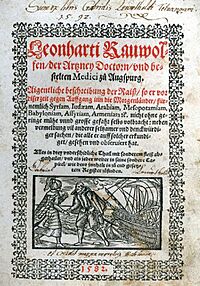Leonhard Rauwolf facts for kids
Quick facts for kids
Leonhard Rauwolf
|
|
|---|---|

The front page of Rauwolff's travel book dated 1582
|
|
| Born | 21 June 1535 Augsburg, Germany
|
| Died | 15 September 1596 (aged 61) Waitzen, Hungary
|
| Nationality | German |
| Occupation | physician botanist |
| Known for | Travel in the Levant |
Leonhard Rauwolf (born June 21, 1535 – died September 15, 1596) was a German doctor, plant expert, and explorer. He is famous for his journey through the Middle East between 1573 and 1575. He went on this trip to find new plants for medicines. When he came back, he wrote about the plants he found. He also wrote a book about his travels.
Contents
Early Life and Studies
Leonhard Rauwolf was born in Augsburg, Germany. He first studied at the University of Wittenberg. Later, he studied plants and medicine in France. He attended the University of Montpellier and the University of Valence.
In 1560, he learned from a famous teacher named Guillaume Rondelet. In 1564, he met another well-known plant expert, Carolus Clusius. In 1565, Rauwolf started his own medical practice. This was in his hometown of Augsburg. He also got married that same year.
Adventures in the Middle East
Rauwolf's exciting journey to the Near East was made possible by his brother-in-law, Melchior Manlich. Manlich hoped Rauwolf would discover new plants and medicines. These could then be sold by his trading company. The company already traded with people in Tripoli in Lebanon.
Rauwolf began his trip in Augsburg. He traveled to Marseilles in southern France. From there, he sailed to Tripoli in 1573. He then went to Aleppo, where he stayed for many months.
In 1574, he traveled from Aleppo to Baghdad and Mosul. The next year, 1575, he returned to Aleppo and Tripoli. He then visited Jerusalem. Finally, he arrived back in Augsburg in 1576. Rauwolf was the first European plant expert to explore Syria and Mesopotamia in this way.
Soon after his return, he shared what he found. He published a book about the plants he collected. It was called "Viertes Kreutterbuech -- darein vil schoene und frembde Kreutter".
Travel Stories and Discoveries
Besides studying plants, Rauwolf also wrote about the people he met. He described their customs and the places he saw. In 1582, he published these observations in a German book. Its title was "Aigentliche Beschreibung der Raiß inn die Morgenländerin".
An English version of his book came out in 1693. It was called "Dr. Leonhart Rauwolf's Travels into the Eastern Countries". This book was part of a larger collection of travel stories. Rauwolf was one of the first Europeans to write about drinking coffee. At that time, coffee was unknown in Europe.
He wrote: "A very good drink they call Chaube that is almost as black as ink. It is very good in illness, especially of the stomach. This they drink in the morning early in the open places before everybody. They drink it out of China cups, as hot as they can, sipping it a little at a time."
Here is a small part of what Rauwolf wrote about Tripoli in Lebanon:
-
- The town of Tripoli is quite big and full of people. Many goods are brought there every day by sea and land. It is in a lovely area, near the high mountain Libanus. It sits on a large plain by the sea. You can see many vineyards and beautiful gardens there. These gardens are mostly surrounded by hedges. The hedges are made of plants like Rhamnus and Balaustium.
Later Life and Legacy
In 1588, the leaders of Augsburg changed back to Catholicism. Rauwolf, who was a Protestant, left the city. He then worked as a city doctor in Linz for eight years.
In 1596, he joined the army fighting the Turks in Hungary. He died there in Waitzen. This was a year before a big battle happened there.
A plant group called Rauvolfia was named after him. This happened in the 1700s. Also, the plant group Alhagi got its name from Rauwolf's writings about plants.


